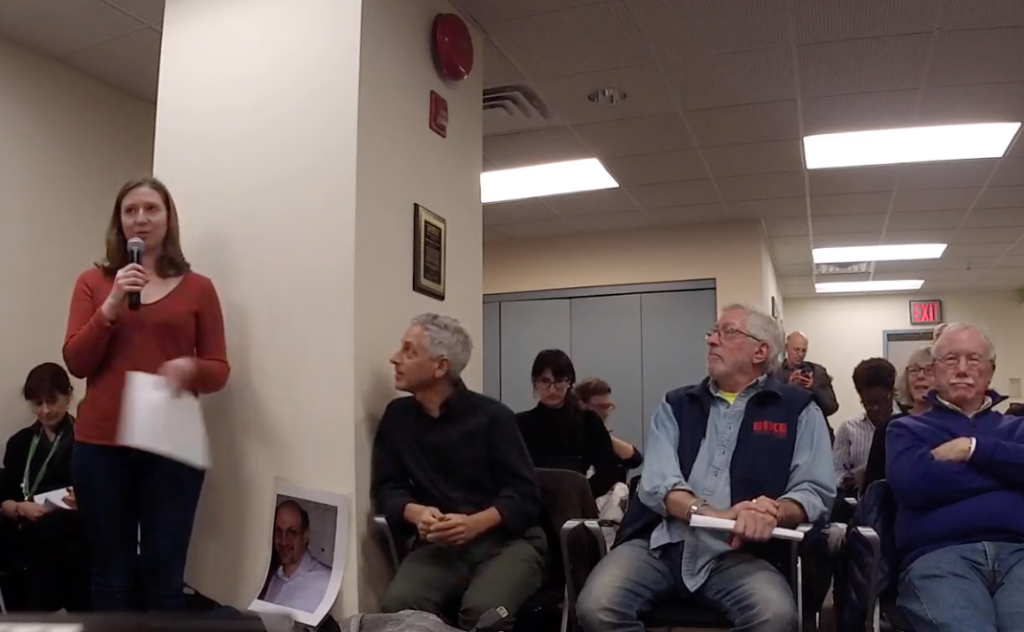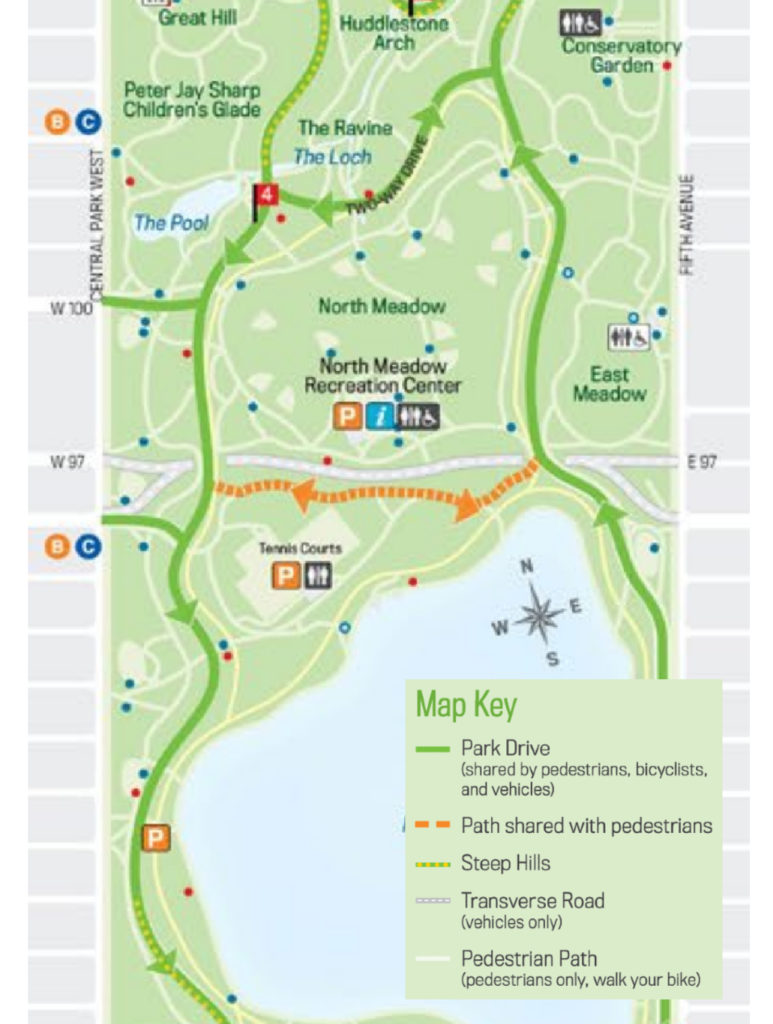
By Alex Israel
The community came together to discuss opportunities for safer crosstown pedestrian and cyclist routes through Central Park during a January joint meeting between Community Board 7’s Transportation and Parks & Environment Committees.
The meeting was scheduled in part as a response to the death of Dr. Daniel Cammerman in late 2019. Cammerman was struck and killed by a school bus crossing Central Park on the 96th Street transverse after hitting a curb or a patch of ice and falling, according to police. Prior to Cammerman’s accident, Transportation Alternatives had set up a petition asking for protected lanes and pedestrian improvements at various cross-park roads, including the 96th Street Transverse.
Currently, the only direct way for cyclists to cross the park is via the Park Drive at 72nd Street, using a path shared by pedestrians, bicyclists, and vehicles. Cyclists can also enter or exit the park at the West side via 96th Street to use a path shared by bicyclists and pedestrians—though all methods of entering or exiting the park on the East side are marked as pedestrian-only. A Park Drive that runs between 100th and 102nd Streets also allows bicycle access from the West side, but again changes to pedestrian-only distinction on the East side.

No one city agency or organization is singularly responsible for Central Park; when it comes to issues regarding transportation within the park, the jurisdiction is split between several stakeholders.
Representatives from each introduced themselves at the beginning of the CB7 meeting, including: Colleen Chatergoon, Community Coordinator for the NYC Department of Transportation (DOT); Caroline Greenleaf, Director, Community and Government Relations at Central Park Conservancy (CPC); and Deputy Inspector Naoki Yaguchi of the New York Police Department (NYPD) Central Park Precinct. Steve Simon, Chief of Staff to the NYC Department of Parks and Recreation (DPR) Manhattan Borough Commissioner was unable to attend the meeting.
Each city representative said they were in attendance to listen to community feedback and take it back to their respective agency. Greenleaf added that CPC, a private non-profit,”doesn’t make decisions about things like this,” but was working closely with DOT and DPR following the “horrible and tragic accident.”
Several community members — primarily cyclists who frequent Central Park — showed up to share their experiences and call for action from the city.
Andy Rosenthal, an Upper West Side resident for 30 years, kicked off the testimony. “I’m thankful that you’re here tonight,” he said, addressing Chattergoon and Greenleaf. “But I’m angry,” he followed. He said he was present for a Community Board 7 meeting around 10 years ago where upgrades to the 96th Street bike path—that he believed would have “saved” Cammerman—were discussed. This time around, “let’s do something,” he urged.
Others echoed his complaints with the quality of the path. “I wish CPC would restore that path so that it looked as good in reality as it does on a map,” said one local cyclist.
One woman, who commutes from the Upper West Side to the Upper East Side for work, said she has been yelled at by pedestrians while biking the path because of unclear signage. “We need more and better options,” she said.
Lisa Orman, a representative for Streetopia Upper West Side, clarified that there are two separate issues to address within the park. “We need paths through the park and transverses to be safe.”
Greenleaf acknowledged that the the park was not designed for cross-commuting—but that CPC was open to hearing all options put forth by city agencies. “[Central Park] is a scenic and wonderful place that is a sanctuary for everyone that goes into it,” she said, “but was never designed for what people are demanding as a current use.”
“I don’t know what the thinking was at the time,” answered Chattergoon, when asked about DOT plans, past or present, for incorporating cyclist paths into the park and its transverses. But given the citywide growth in cycling, “it’s something that we have to reevaluate,” she said. “There is a clear need to start thinking about it.”
Transportation Committee member and avid cyclist Ken Coughlin lamented DOT’s reactive approach. The city’s boom in bike ridership happened because of city agencies’ efforts to install safe cycling paths, he said—but their lack of action in the park is concerning. “It’s incredible to me that city officials up until now have not considered the danger of crossing Central Park [by bike],” he said.
Following a suggestion that existing sidewalks within transverses be converted into bike lanes, Parks & Environment Committee co-chair Klari Neuwelt warned against the idea. “I am very skeptical about any conceivable safe use of the transverses for cyclists and pedestrians,” she said. While she said she was open to hearing the agencies’ recommendations, she reiterated a more urgent need to determine whether or not there is a way to add safe cyclist and pedestrian crossings at the park’s surface level.
“Like Central Park West, it takes someone dying for this conversation to have any traction,” said Transportation Committee member Richard Robbins, in reference to the protected bike lane approved by CB7 and partially installed last year along Central Park West following the death of Madison Jane Lyden in 2018. Between DOT, DPR, NYPD, and CPC, there’s no one owner of this issue, he said. “And we need someone to own this issue.”
Ultimately, the committees decided to draft a joint resolution to compel the city to act. The resolution, proposed and outlined by Robbins, calls for: “short term action,” including the implementation of clear signage of where wheeled vehicles (e.g. bicycles) are allowed within the park; “stricter enforcement of motor vehicle speeding on the transverses,” including the addition of ‘Your Speed’ signs; the creation of a cross-agency task force with representatives from each city agency; and a request for that task force to return to CB7 as soon as possible (no later than March) with proposed solutions.
The resolution passed, receiving majority support from both Transportation and Parks & Environment Committees, and will be up for a vote during the next full board meeting on February 4, 2020.








There is an error in the article:
“Cyclists can also enter or exit the park at the West side via 95th Street”
There is no entrance or exit from at the park on the West Side at 95th Street. The nearest entrance is West 96th Street, just as the map shows.
Thanks, the article has been updated.
I recently bicycled across the park where the doctor was killed. Not again! Truly unsafe. If there’s ice on the road the danger level multiplies. And there’s no room for a bike path unless they eliminate the pedestrian sidewalk, which would actually make sense. Pedestrians have other options to get across.
Meantime I’ll go out of my way up to CP North where it’s much safer or use the internal service road at 102.
No they don’t!
Reason why sidewalks were included with transverses was to give pedestrians access to get straight through CP.
Even with twists/curves the transverses are still the most direct routes through Central Park. They are also far safer than walking through park late/over night.
Oh please, I’ve walked across the park plenty of times and have not once taken the transverse. It’s a pleasant walk if you go along the pedstrian paths. I guess it’s not as “direct” as the transverse but if you’re in a hurry you wouldn’t be walking in the first place.
Not in favor say: I
Has the idea of moving at least some of the transverses underground?
The streets crossing the park are so narrow.. They need to be widened for this to work.
The transverses are like highways and should be off limits to pedestrians and bikes. The shared pedestrian walkways are the safer crosstown options. It may take a little longer to travel, but fixing or enhancing hem should be the priority.
Since Central Park was laid out long before “highways” were in existence don’t see the comparison.
Traverses are what their name implies; a way to get east or west pretty directly though an otherwise solid carving out of land from street grid.
At the time it was for horses, carriages drawn by them, and pedestrians. First two have been replaced by motor vehicles, but rest remains.
Don’t see why so many are dead set to punish pedestrians using transverses (and quite a few do), just to push yet more bike lanes through.
When motor vehicles were banned totally from CP supporters of that goal chirped “they can use the transverses”. That is exactly where all such traffic has been diverted to get east or west (besides CPS, CPN, Fifth avenue and CPW), now same people want to close transverses to cars/trucks as well.
Designed after the Civil War, horse drawn carriages were the intended vehicles. Motorized vehicles are the primary users of the transverses. The 97 Street transverse has seen many problems in the past, including major flooding. Mixing pedestrians and vehicles is not a sensible approach on our streets. Both pedestrians and cyclists are taking unnecessary risks when using the transverses. The pedestrian walkways are too narrow to be safe and should have been closed long ago.
Pedestrians have sidewalk, cars/trucks have roadway, transverses do not “mix” anything.
By your logic we shouldn’t have sidewalks along side streets because it “mixes” two types of traffic.
Unlike other city streets, the separation between pedestrians is minimal. Pedestrians often walk into the street while traffic is moving. Users of the street need better ways to remind them of the separation of uses.
The transverses are not safe.
https://mapio.net/images-p/9555259.jpg
Speeding cars, 30-40 mph or more.
https://www.youtube.com/watch?v=zMgFQaZBoOA
No buffer zones such as parked cars or barricades for protection.
Extremely narrow in some sections where pedestrians must walk on the roadway.
https://i.pinimg.com/originals/6c/73/b4/6c73b412091275a5e51f7ea0dbe84fda.jpg
Numerous obstacles like signs, street lights and hydrants or even other people. Pedestrians may have to step onto roadway to pass obstacles.
Minimal space for cars to pull over.
Poorly lit with occasional street lights. Pedestrians may rely on vehicle headlights for illumination.
Poor drainage, flooding occurs often in bad weather.
https://newyork.cbslocal.com/wp-content/uploads/sites/14578484/2018/04/screengrab-00003.jpg
Badly maintained crumbling or heaving sidewalks allowing water to accumulate.
Impassible when snow and fallen leaves accumilating in fall and winter months.
Few access/exit points for pedestrians who may want to change their minds but are now committed to the crossing.
Signage for vehicles but poorly designed for pedestrians and cyclists. Pedestrians and cyclists are not made aware of alternative routes when entering the transverses.
https://live.staticflickr.com/2028/2414017683_d2aa29bb65_b.jpg
Whenever possible, pedestrians and cyclists should avoid the transverses and use safer alternative crosstown routes.
I have cycled on both the 96th and 86th St transverses and truly feared for my life. The city buses are huge, and they can’t see you.
To be clear, we’ve been asking for safer crosstown routes for over a decade. It only took a death to bring it to the table.
Oh, please, not the “your speed” signs again! The temporary variety usually gets parked on a sidewalk, which would only push pedestrians into traffic.
As a daily driver through the park I support closing at least one transverse to vehicles completely. Turning transverse roads one way + a bike lane would also work. Trucks must be banned too: if only I could have a penny for each near head on collision with a huge truck.
My theory is that making driving more difficult will eventually cause the impatient a-holes to move away, leaving the road clear for cyclists and those drivers who can actually follow rules of the road and drive courteously.
Wow – someone has a little angst.
Cars aren’t going away, and closing a transverse to them isn’t going to help. It will cause more congestion and make life miserable for bus riders, of which there are many of all ages, income levels, etc. For some of the UWS, the closest hospital is Lenox Hill, so it would also literally risk people’s lives by delaying their trips to the hospital.
Enhance the cross town path that already exists and make it well lit with clear marking of lanes for pedestrians and bikes. It really isn’t that hard. Then let’s tackle some of the city’s bigger problems.
Construction/renovation trucks idle all day if they have the luxury of finding an empty space. They crash supplies, renovation waste, banging and spewing toxic dust everywhere all day long. I haven’t seen any silent clean trucks that don’t idle. Just think if they had the whole street of empty spaces to themselves.
Delivery hours? This is not about delivery trucks.
Cars are going away.
New York was never made for them and banning them will improve the city immensely. The best way to speed up busses and ambulances is to ban free parking and take back the two lanes on every street that we give away.
Cars are going away so 2 lanes on every street will then be filled with noisy polluting trucks!
You think cars arent dirty or loud? The benefit is that trucks have delivery hours and dont idle for alternate-street side parking, etc etc
Make the transverse one way and 55,000 bus riders would have 10-15 minutes added to their day for the convenience of you and whom else?
Paul, you nailed it.
So just where to you intend for cross town buses to get from UWS to UES and vice versa?
Which transverse do you intend to surrender to this proposal? Send M96 down to 86th? Send M72 up to W81st?
Every time a cyclist is killed Howard Yaruss, Chair of CB7’s Transportation committee capitalizes on the tragedy to install yet another bike lane on the UWS. Yaruss does not act like a public servant and does not represent all of the citizens within the CB7 district with their diverse concerns.He represents one constituency and one constituency only: Bike riders and IMO he is virulently anti car. The era of the Yaruss dictatorship must end. Install a Transportation Chair who is willing to work on issues besides bikes.
Do you see bike lanes filled with the aging population of the UWS? I don’t. I see a few bicyclers, most of which are unhelmeted tourists in Citibikes. Then there are the many electric bikes with no legally mandated notice of the restaurant they work for speeding and weaving every which way in the bike lanes and in the streets as it suits them irrespective of direction and traffic lights terrorizing pedestrians. All those expensive, traffic-lane hogging and traffic-congestion causing bike lanes installed and no one uses them that much or properly. All due to one man’s (Howard Yaruss) obsession.
I’d say you aren’t really looking, if that’s what you “see”. There are verifiable facts about how much the bike lanes are used. You may choose to ignore facts, but that doesn’t mean they don’t exist.
Bikes are here to stay and they have every right to have a safe place ride as much as your car.
I’d rather he represent all of the UWS of which car owners are a small proportion. UWS bikers and pedestrians are finally starting to get recognized as being equal to car owners, which I fully support.
Fully equal, despite fewer than a quarter of UWS’ers owning cars. Whatever it takes for progress for pedestrians and cyclists, I’ll take it!
35% of us are in households with cars.
Far more of us reverse commute in cars than ride bikes to work.
And the carnage is caused by commercial drivers, not residents.
I’ve found for riding the only two safe paths for biking is that 102nd on East side to 100th on west side and then further south at 72nd. Did the transverse sat 96th and 81st and both are just too dangerous for biking.